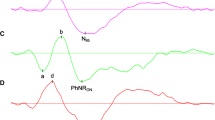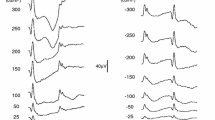Abstract
Pattern onset electroretinograms (PERGs) were recorded from four normal subjects. Square-wave gratings of 75% contrast were presented in three approximately contiguous, concentric zones of outer angular radius, 5.1°, 12.6°, and 23.6°. The zones were calculated to give equal numbers of ganglion cell receptive fields. The recorded PERGs were considered to include luminance and pattern components which have low and bandpass spatial tuning functions respectively. These components combine in the PERG to produce a broad spatial tuning characteristic. The amplitude of PERGs in response to low spatial frequency stimuli is widely reported to be linearly related to contrast. The retinal illuminance response at every spatial frequency was computed from the eye's modulation transfer function. This function characterizes the reduction in contrast that occurs because of optical degradation. The computed retinal illuminance response was subtracted from the PERG waveform and a pattern-specific response was revealed. The latter had a highly tuned bandpass function which peaked at higher spatial frequencies than the PERG at corresponding peripheral angles.
Similar content being viewed by others
References
Arden GB, Vaegan. Electroretinograms evoked in man by local uniform or patterned stimulation. J Physiol 1983; 341: 85–104.
Arden GB, Vaegan, Hogg CR. Clinical and experimental evidence that the pattern electroretinogram (PERG) is generated in more proximal retinal layers than the focal electroretinogram (FERG). Ann NY Acad Sci 1982; 388: 580–601.
Baker CL, Hess R. Linear and nonlinear components of human electroretinogram. J Neurophysiol 1984; 51: 952–967.
Brindley GS, Westheimer G. The spatial properties of the human electroretinogram. J Physiol 1965; 179: 518–536.
Campbell FW, Gubisch RW. Optical quality of the human eye. J Physiol 1966; 186: 558–578.
Dawson WW, Stratton RD, Hope GM, Parmar R, Engel HM, Kessler MJ. Tissue responses of the monkey retina: tuning and dependence on inner layer integrity. Invest Ophthalmol Vis Sci 1986; 27: 734–745.
Drasdo N. The neural representaion of visual space. Nature 1977; 266: 554–556.
Drasdo N. Optical techniques for enhancing the specificity of visual evoked potentials. Doc. Ophthalmed Proc Series 1982; 31: 327–336.
Drasdo N, Thompson DA, Thompson CM, Edwards LE. Complementary components and local variations of the pattern electroretinogram. Invest Ophthalmol Vis Sci 1987; 28: 158–162.
Hess R, Baker CL. Human pattern-evoked electroretinogram. J Neurophysiol 1984; 51: 939–951.
Hess R, Baker CL, Zrenner E, Schwartzer J. Differences between electroretinograms of cat and primate. J Neurophysiol 1986; 56: 747–768.
Holden AL, Vaegan. Comparison of the focal electroretinogram and the pattern electroretinogram in the pigeon. J Physiol 1983; 344: 11–23.
Jennings JAM, Charman WN. Off axis image quality in the human eye. Vis Res 1981; 21: 445–455.
Korth M. Pattern evoked responses and luminance evoked responses in the human electroretinogram. J Physiol 1983; 337: 451–469.
Korth M, Rix R. Effect of intensity and contrast on the pattern ERG. Ophthalmic Res 1984; 16: 60–62.
Korth M, Rix R. Changes in spatial selectivity of pattern-ERG components with stimulus contrast. Graefes Arch Clin Exp Ophthalmol 1985; 223: 23–28.
Maffei L, Fiorentini A. Electroretinographic responses to alternating gratings before and after section of the optic nerve. Science 1981; 211: 953–955.
Maffei L, Fiorentini A, Bisti S, Hollander H. Pattern ERG in the monkey after section of the optic nerve. Exp Brain Res 1985; 59: 423–425.
Missotten L. Estimation of the ratio of cones to neurons in the fovea of the human retina. Invest Ophthalmol Vis Sci 1974; 13: 1045–1049.
Odom JV, Norcia AM. Retinal and cortical potentials; spatial an temporal characteristics. Doc Ophthalmol Proc Series 1984; 40: 29–37.
Padmos P, Haaijman J, Spekreijse H. Visually evoked cortical potentials to patterned stimuli in monkey and man. Electroencephalogr Clin Neurophysiol 1973; 35: 153–163.
Polyak SL. The vertebrate visual system. Chicago: University of Chicago Press; 1957.
Riemslag FCC, Ringo J, Spekreijse H, Verduyn Lunel H. The luminance origin of the pattern electroretinogram in man. J Physiol 1985; 363: 191–209.
Riemslag FCC, Heynen HGM. Depth profile of pattern and local electroretinograms in macaque. Doc. Ophthalmol Proc Series 1984; 140: 143–148.
Ripps H, Witkovsky P. Neuron-glia interaction in the brain and retina. Prog Ret Res 1985; 4: 181–212.
Rovamo J. Receptive field density of retinal ganglion cells and cortical magnification factor in man. Med Biol 1978; 56: 97–102.
Spekreijse H, van der Tweel, Zuidema TH. Contrast evoked responses in man. Vis Res 1973; 13: 1577–1601.
Teping C, Groneberg A. Physiological basis and clinical application of pattern electroretinogram. Devel Ophthalmol 1984; 9: 74–80.
Walsh G, Charman N. Measurement of the axial wavefront aberration of the human eye. Ophthalmic Physiol Optics 1985; 5: 23–32.
Werblin FS, Dowling JE. Organisation of the retina Mudpuppy Necturus maculosus II intracellular recording. J Neurophysiol 1969; 32: 339–354.
Author information
Authors and Affiliations
Rights and permissions
About this article
Cite this article
Thompson, D.A., Drasdo, N. Computation of the luminance and pattern components of the bar pattern electroretinogram. Doc Ophthalmol 66, 233–244 (1987). https://doi.org/10.1007/BF00145237
Issue Date:
DOI: https://doi.org/10.1007/BF00145237




